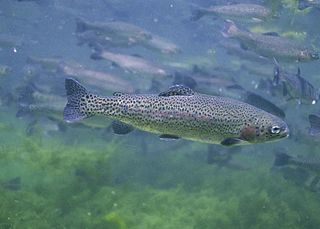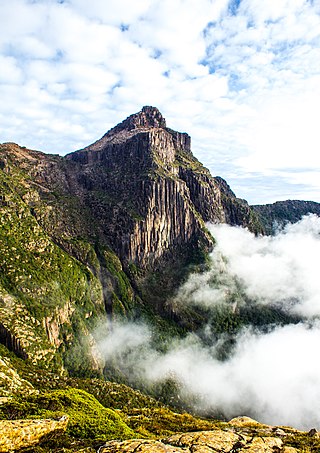
Hobart ( HOH-bart; is the capital and most populous city of the island state of Tasmania, Australia. Located in Tasmania's south-east on the estuary of the River Derwent, it is the southernmost capital city in Australia. Despite containing nearly half of Tasmania's population, Hobart is the least-populated Australian state capital city, and second-smallest by population and area after Darwin if territories are taken into account. Its skyline is dominated by the 1,271-metre kunanyi / Mount Wellington, and its harbour forms the second-deepest natural port in the world, with much of the city's waterfront consisting of reclaimed land. The metropolitan area is often referred to as Greater Hobart, to differentiate it from the City of Hobart, one of the seven local government areas that cover the city. It has a mild maritime climate.

The River Derwent, also known as timtumili minanya in palawa kani, is a significant river and tidal estuary in Tasmania, Australia. It begins its journey as a freshwater river in the Central Highlands at Lake St Clair, descending over 700 metres (2,300 ft) across a distance of more than 200 kilometres (120 mi). At the settlement of New Norfolk in the Derwent Valley its waters become brackish, flowing through Hobart, the capital city of Tasmania, its seawater estuary eventually empties into Storm Bay and the Tasman Sea.

Derwent Valley Council is a local government body situated in southern-central Tasmania, west of Hobart. Derwent Valley is classified as a rural local government area and has a population of 10,290, it includes the localities of Bushy Park, Maydena and Strathgordon, with New Norfolk the major, principal town.

Huonville is a town on the Huon River, in the south-east of Tasmania, Australia. It is the seat of the Huon Valley Council area and lies 38 km south of Hobart on the Huon Highway. At the 2016 census, Huonville had a population of 2,714 and at the 2011 census had a population of 1,741.

New Norfolk is a town on the River Derwent, in the south-east of Tasmania, Australia. With a population of 6,153 in 2021, New Norfolk is the principal township of the Derwent Valley region. Located within the Derwent Valley Council, New Norfolk is situated 32 kilometres (20 mi) north-west of the state capital Hobart on the Lyell Highway and classified as part of the Greater Hobart statistical area.

The rainbow trout is a species of trout native to cold-water tributaries of the Pacific Ocean in North America and Asia. The steelhead is an anadromous (sea-run) form of the coastal rainbow trout(O. m. irideus) or Columbia River redband trout (O. m. gairdneri) that usually returns to freshwater to spawn after living two to three years in the ocean. Freshwater forms that have been introduced into the Great Lakes and migrate into tributaries to spawn are also called steelhead.

Jindabyne is a town in south-east New South Wales, Australia that overlooks Lake Jindabyne near the Snowy Mountains, in Snowy Monaro Regional Council. It is a popular holiday destination year round, especially in winter. This is due to its proximity to major ski resort developments within the Kosciuszko National Park, including Thredbo, Perisher and Charlotte Pass.

The Central Highlands is a region in Tasmania, Australia where geographical and administrative boundaries closely coincide. It is also known as The Lake Country of Tasmania.

The Huon Valley, or simply the Huon, is a valley and geographic area located in southern Tasmania, Australia. The largest town is Huonville, with other smaller towns spread across the area. It includes Australia's most southern permanent settlement at Southport. The Huon Valley Council area had a population of 15,140 in 2011. Famed for its apple growing, the Valley was first settled by British colonists in the 1820s; prior to settlement the Huon Valley area was inhabited by the Mouheneenner, Nuenonne, Mellukerdee and Lyluequonny people.

South West Tasmania is a region in Tasmania that has evoked curiosity and wonder during the period of European presence on the island.
Plenty is a rural locality in the local government area (LGA) of Derwent Valley in the South-east LGA region of Tasmania. The locality is about 9 kilometres (5.6 mi) north-west of the town of New Norfolk. The 2016 census recorded a population of 93 for the state suburb of Plenty. It is a small locality and the name of a tributary river on the south side of the River Derwent in the Derwent Valley.
This page is a list of fishing topics.
The Tasmanian Trail is a long distance path in Tasmania, Australia. It was inspired by the Bicentennial National Trail opened on the mainland in 1988.

Aquaculture in Australia is the country's fastest-growing primary industry, accounting for 34% of the total gross value of production of seafood. 10 species of fish are farmed in Australia, and production is dominated by southern bluefin tuna, Atlantic salmon and barramundi. Mud crabs have also been cultivated in Australia for many years, sometimes leading to over-exploitation. Traditionally, this aquaculture was limited to table oysters and pearls, but since the early 1970s, there has been significant research and commercial development of other forms of aquaculture, including finfish, crustaceans, and molluscs.
Forestry in Tasmania Australia has been conducted since early European settlement. The logging of old growth native forests in the state has been opposed by environmentalists and others via means such as lobbying, legislation and blockades.
Louis Manton Shoobridge Sr. was an Australian politician. He was born in New Norfolk, Van Diemen's Land. He unsuccessfully contested the 1914 Senate election as a Liberal candidate and the 1919 election for the federal seat of Franklin as a Nationalist candidate. In 1921 he was elected to the Tasmanian Legislative Council as the Independent member for Derwent, serving until his retirement in 1937. His father Ebenezer Shoobridge, brother William Shoobridge, son Rupert Shoobridge and grandson Louis Shoobridge Jr. were all members of the Tasmanian Parliament.
TYGA FM is a community radio station located in New Norfolk, Tasmania, Australia, broadcasting on 98.9 MHz.

Ebenezer Shoobridge (1820–1901) was an Australian politician. He represented the Electoral district of New Norfolk in the Tasmanian House of Assembly from the 1882 election until he was defeated at the 1886 election.
Bushy Park is a rural locality and town in the local government area of Derwent Valley in the South-east region of Tasmania. It is located about 19 kilometres (12 mi) north-west of the town of New Norfolk. The 2016 census determined a population of 126 for the state suburb of Bushy Park.

Hinsby Beach is a beach along the River Derwent in the Hobart suburb of Taroona, Australia. The south facing beach looks directly out to Storm Bay and the Tasman Sea, with views of the Derwent estuary, the Alum Cliffs, Taroona Shot Tower, the City of Clarence on the eastern shore and Opossum Bay, South Arm. Hinsby Beach is situated between the Alum Cliffs and Taroona Beach. A naturally secluded section of the beach, beyond the rocky south-western outcrop is a zoned naturist beach.















